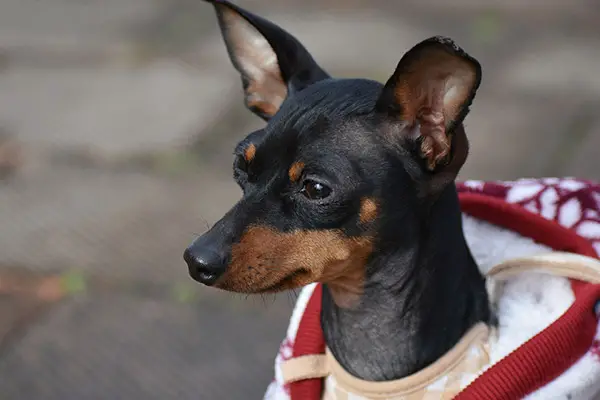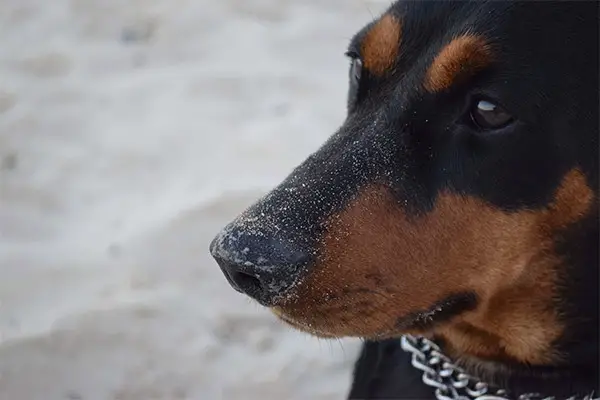German Pinschers are medium-sized dogs mainly used as a versatile farm dog and ratter in history. The German Pinscher features a muscular body and sleek, shiny coats of red or black-and-blue with red accents. They also have an elongated, wedge-shaped head and dark eyes that depicts alertness.
German Pinschers are undeniably elegant-looking and will capture your heart in seconds. However, you should make sure that you’re experienced enough to handle this breed. These dogs can be challenging to handle, and they will try to take charge.
These dogs are smart, and if trained well, you will surely love their company. They are happy, loving, and affectionate dogs which will make a great addition to families.

German Pinscher Breed Statistics
| Dog Breed Group | Working Group |
| Breed Size | Medium |
| Height | 17-20 inches |
| Weight | 25-45 pounds |
| Lifespan | 12-14 years |
German Pinscher Breed Ratings
| Energy level | |
| Exercise needs | |
| Requires attention | |
| Playfulness | |
| Trainability | |
| Shedding | |
| Grooming | |
| Friendly with family | |
| Friendly with kids | |
| Friendly with strangers | |
| Friendly with other dogs | |
| Prey Drive |
German Pinscher History
German Pinschers may look like a smaller variety of the Doberman, but the history of these dogs goes way longer than the latter. In fact, it’s one of the oldest german breeds and even founded other German dog breeds.
These dogs were developed in Germany between the late 1700s and the late 1800s to eradicate vermin in the area. There are no certain records of the exact time they were developed, but paintings from 1780 showed dogs of similar appearance. The breed also appeared in a book that dated in 1884.
German Pinschers are descendants of Rat Pinschers. A breed that no longer exists and became extinct in the early 1800s. The German Pinschers also went close to extinction during the two world wars where two breed colors died out.
Fortunately, thanks to the efforts of one man, Werner Jung, the breed was saved. Importation to the US began in the late 1970s, and the American Kennel Club recognized dogs in 2003.
German Pinscher Temperament
German Pinschers are best described as courageous, intelligent, and vivacious dogs. Their strong-willed and assertive temperaments make them compatible only to experienced owners who can provide firm leadership.
It’s always best to train them while they’re young, so they don’t take over your home. But if trained well, they can be very devoted family members.
These dogs are adaptable to any type of living, but it’s highly essential to give them the exercise they need. If you have a large, securely fenced yard, then that’s better. It’s also best if you’re outgoing too so that you can cope with these dog’s energy.
This is not the dog to get for families with toddlers. German Pinschers have strong prey drive, and they might chase anything smaller to them, which might include kids. However, they are known to be great playmates for older children.
German Pinschers are territorial, and they take their watchdogs position seriously. You can expect them not to be trusting with strangers, they will bark, but they are not aggressive.
Socialization is crucial for these dogs. Help them get accustomed to new people, animals, and things, so they also get to know how to appropriately approach the situation. This will also help in making them more well-rounded dogs, and encourage a stable temperament.
Training these dogs can be challenging. They need someone who can provide firm and consistent training without being harsh. Keep training sessions interesting, too. If you think you can’t do this on your own, then you can also enroll your dog to a puppy school.

German Pinscher Care Requirements
- Nutrition: German Pinschers can live in any type of diet. However, you have to make sure that they only eat high-quality and well-balanced meals. Every meal should contain a balance of proteins, fats, and carbohydrates. If you’re feeding your dog a raw or home-cooked diet, it’s essential to buy only high-quality ingredients. It’s also great to incorporate fruits and vegetables in your dog’s diet to make food digestion easier. If you’re feeding him dog food, choose the premium quality ones. It’s also important to check the label and ensure that the food doesn’t contain fillers, additives, and by-products. Take note of any allergies your dog may have, and make sure to stay away from those.
- Grooming: German Pinschers have short, dense coats that require very little maintenance. It occasionally sheds, which may only need weekly brushing to keep it neat. Baths can be given occasionally too, depending on your dog’s activities, just to give their coats a shiny look. As for the ears, make sure to clean them regularly to prevent ear infection. Nails should be trimmed regularly as well. The recommended frequency is twice a month, which will help ensure the nails don’t become too long and cause pain and discomfort.
- Exercise: German Pinschers are agile and athletic dogs that require lots of activities to keep them healthy, fit, and happy. It’s best to create activities that will help stimulate not only their body but also their minds. Taking them out for long walks is good, but it’s better to give them a more highly impacting exercise. You can go on running, biking, or chasing balls until he gets tired. Just make sure to keep him on-leash or in a securely fenced area. Making him participate in canine sports is a great idea too. This way, he’ll be able to showcase his agility, tracking, rally, and hunting skills.
- Health: German Pinschers are generally healthy dogs that have long lifespans. However, just like any dog breed, they are susceptible to a few health conditions. As dog owners, it’s always best to be aware of those so you may find ways to prevent them. There are only three common conditions you should be worried about: hip dysplasia, cataracts, and Von Willebrand’s disease. There may also be heritable diseases your dog may get, which are not common to the breed, so meeting at least one of your dog’s parents is an excellent course of action. We also recommend doing your research for each disease and its symptoms. Then, closely monitor your dog’s behavior, and if there are changes, take him immediately to the vet for a check-up.
- Lifespan: The life expectancy of German Pinschers is 12-14 years.
Fun Facts about German Pinschers
- German Pinschers, as their name implies, originated from Germany.
- Although they look like the Doberman Pinscher or Miniature Pinscher, this breed is more closely related to the Standard Schnauzer.
- They are descendants of the Rat Pinscher, a now-extinct breed.
- They laid the foundation of several other German dog breeds.
- These dogs are believed to be used to eliminate vermin, herd cattle, and protect households in some areas in Europe.
- The whole dog breed nearly went extinct because of the two world wars.
- The breed was saved thanks to one man’s effort, Werner Jung.
- They were recognized by the American Kennel Club in 2003.

